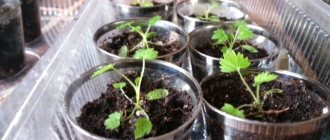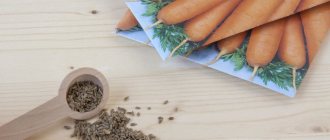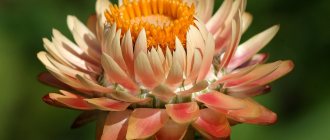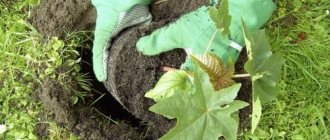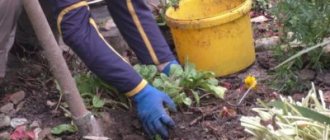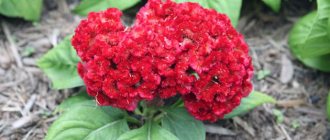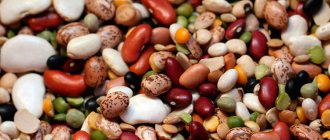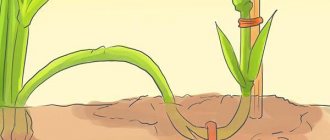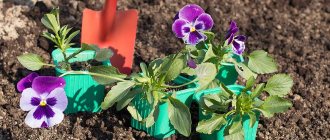Growing primrose from seeds is a unique challenge for the gardener. Success is guaranteed only to those who know how to patiently wait for seedlings to appear, and also know the peculiarities of sowing, which include stratification.
- 2 Soil and containers for sowing seeds
- 3 How to sow primrose correctly
- 4 Stratification and freezing of seeds
4.1 Video: growing primrose from seeds with different types of stratification
How to determine the date of sowing primrose
For normal development, plants need at least 10–12 hours of daylight. Under natural conditions, without lighting, after winter it becomes like this at the end of February and remains favorable until autumn. In addition, it should be taken into account that primrose seedlings appear on the 20–30th day after sowing. Plus, almost all types require stratification:
- Primroses auricular, fine-toothed, polyanthus, giant, pink, when propagated by seed, require stratification lasting from 2-3 weeks to 2-3 months. Check the packaging of your seeds for more details.
- Primrose Julia, ordinary, tall, germinate without stratification. They can be sown in the garden before winter, as well as in the spring for seedlings, in May-April, but even for them, it is sometimes recommended to pre-stratify them on seed packets for 7–10 days to 3–4 weeks.
The need for stratification even for ordinary species is explained by the fact that primrose seeds quickly lose their viability during storage. Ideally, they should be sown immediately after harvest or stored in the refrigerator. The longer seeds are kept warm, the more difficult it is to awaken them, and stratification facilitates this process.
If you have a phytolamp, then you can sow primroses all year round, without thinking about favorable timing. Without lighting, seedlings that appear between October and February will inevitably stretch out, fall to the ground and die from the black leg.
When to sow primrose seeds
Primrose fine-toothed - how to grow at home
Rarely do seeds remain viable until spring. For this reason, they are sown in winter, in February or the first ten days of March. It is permissible to grow seedlings in late autumn (October-November). At the same time, the seedlings bloom earlier.
Planting primrose seeds
Primrose, planting in a flowerbed is carried out as soon as the snow melts. Sow first in a pot or container, which is sprinkled with earth. Regular care is needed, as drying out the soil can harm the seedlings. The plants will bloom by next spring.
Features of summer sowing
Summer sowing is carried out immediately after the seeds ripen. Many summer seedlings tolerate wintering well. After the snow melts, sprouts with 2-3 leaves emerge, and strong, viable plants grow from them.
Late autumn sowing in a flowerbed is possible when the ground freezes. Florists use this method for plants whose seeds require cold stratification. Before winter, large-seeded material of the following varieties is sown:
- stemless;
- polyanthus;
- tall primrose hybrids.
On a note! Pre-winter sowing is convenient when there are a lot of seeds and there is no risk of their death from unforeseen circumstances.
Soil and containers for sowing seeds
The seeds of primroses are very small, the seedlings are delicate, so the soil must be light so that the roots can grow comfortably in it. To create this, buy regular soil for seedlings in a store, a brand you have already tested, and add 1/4 - 1/3 of the total volume of vermiculite to it. Experienced gardeners recommend creating a top layer for crops 2–3 cm thick from one vermiculite or washed coarse sand.
It is recommended to mix soil for primroses with vermiculite and sprinkle it
As for containers, bowls, plastic containers, drawers, and pots 7–10 cm deep are suitable. If there are no drainage holes in the bottom, be sure to make them. Wash reusable containers with soap or soda before filling them with soil.
Home care
Painstaking care at home will require a certain investment of time, but thanks to it, Rosanna apricot will appear in all its glory. The leathery leaves will grow large and prominent, the dark green color will decorate the characteristic pattern. Velvet flowers will become voluminous, and the apricot color will become rich.
Temperature
Primrose is sensitive to air temperature parameters.
Important! Heat above +30°C is destructive for double flowers.
Depending on the season, the following indicators are recommended:
- in winter: +15…+17°С;
- spring: +18…+21°С;
- during flowering: +16…+20°С.
Lighting
Rosanna cannot stand directed sunlight - the foliage will dry out, burns may appear on it, and the flowers will wither prematurely. The variety in question prefers a diffused type of lighting. However, the plant is light-loving, so the habitat should at the same time be well lit.
Location
Primrose requires free space, does not tolerate cramped spaces and is afraid of drafts. It is optimal to place flowers on a windowsill facing east or west, so that there is the required amount of light that is not too intense. If this option is not available, the flower is placed in the shade of another tall plant, but at some distance.
During dormancy (primrose flowering ends in July), the plant should be moved to partial shade. And in winter, place it near the “northern” windows, where there is less light and cooler. In February, when flowering can begin earliest, you should increase the lighting and choose a warmer place.
How to sow primrose correctly
Small seeds create a certain difficulty when sowing: not only are they hard to see, but there is a high probability of blowing them away or accidentally brushing them away and then not finding them. Therefore, be careful and act according to the scheme:
- Pour the prepared soil into the sowing container in a layer of 3–5 cm.
- Moisten the soil. You can add HB-101 (2 drops per 1 liter) or another stimulant to the water.
- Place the seeds on a white saucer or napkin so that they are clearly visible.
Place the seeds on a white surface
- Sow the seeds superficially at a distance of 1 cm from one another, only slightly pressing them into the soil. It is convenient to pry out small seeds and place them with a toothpick dipped in water.
- Cover the crops with a lid or film.
Crops must be kept covered
Further actions depend on the type of primrose. If the variety you choose is grown without stratification, this does not mean that all difficulties have passed you by. You should find out whether light is needed for seed germination. For example, fine-toothed primrose is germinated in the dark, and common primrose in the light.
That is, immediately after sowing or stratification (if it is needed), the first boxes are covered from light with an opaque lid until the shoots appear, and the second boxes are placed on a bright window or under a phytolamp.
The nuances of sowing itself
Tiny and “delicate” primrose seeds do not need to be embedded in the ground; moreover, such treatment reduces their germination rate to zero.
Instead, the planting container is filled with a layer of substrate 5-8 cm thick and lightly slammed with the palm of your hand, compacting it so that the seeds do not fall into the depths.
If there are a lot of seeds, you can simply scatter them, but if there is a shortage of them or you want to simplify your task for the upcoming picking, you can pick each one up on a wet toothpick and place it at approximately the same distance from one another. Anyway, there should be no more than 5 pieces per square centimeter.
Then the seeds are moistened with warm water from a spray bottle. You can dissolve a couple of drops of fungicide in it to prevent damage to seedlings by blackleg.
Stratification and freezing of seeds
There are several ways to stratify. The most popular is in the refrigerator, it is complemented by keeping the crops warm. It is believed that in this way they are created as close as possible to natural conditions. After all, at the end of summer - in the fall, a seed falls into warm and moist soil, swells there, and then overwinters.
Stratification stages:
- Keep the crops for a day at room temperature, this is enough for the seeds to swell. For slow-germinating varieties, it is recommended to extend the warm period to 2 weeks. Even better: put it in the refrigerator at night, and put it in a warm place for the day (+16… +18 °C).
- After the warm period, send the crops to remain in the refrigerator permanently.
- Once a week, take it out, open it, remove condensation from the lid, and if necessary, moisten the soil.
- Towards the end of the stratification period, check every day; shoots may appear right in the refrigerator and, remaining unnoticed, will stretch out in the dark.
Shoots may appear already in the refrigerator
Forgetful or too busy gardeners are recommended to stratify with freezing. In the cold, the seeds will definitely not germinate ahead of schedule, but they will feel the change in temperature. Freezing options:
- Keep the purchased seeds directly in store packaging in the refrigerator for 2-3 weeks, and then put them in the freezer for 2-3 days.
- Bury the pot of crops under the snow for 2–3 weeks.
- Sow in a pot in the fall and bury it in the garden until spring. Small seedlings in a pot will not get lost among the weeds.
Video: growing primrose from seeds with different types of stratification
Selection of planting material
Of all the options, propagating primrose by seeds is the most labor-intensive and time-consuming method. However, if you go through it to the end, the end result is a strong and healthy plant that will easily tolerate relocation to open ground, and will delight you with bright flowering in the flowerbed for the next ten years. Proper selection of seeds for planting is the key to successful cultivation; take this task responsibly.
Remember the rule - the older the seed, the longer you will wait for it to sprout.
If you want confidence in the quality of planting material, collect primrose seeds with your own hands. Even with proper organization of storage of primrose seeds in winter, next season the seed germination rate will drop to 60%. Collect primrose seeds together with the seed box. After collection, place the boxes in a dark place for the material to ripen. Monitor the air temperature in the room: at temperatures above +20 degrees, the seeds will die.
Seed certification
The artificial creation of natural conditions for plant growth is called stratification. The method is that the seeds are first allowed to swell and then placed in the cold, simulating their presence in the ground under the snow. Thanks to this method, the seeds will sprout on time and will be transplanted into open ground as already grown seedlings.
I will describe several ways to stratify primrose seeds:
- Keep the primrose seeds on a warm windowsill for several days, then place them in a plastic bag in the ground and place them in the refrigerator or freezer. Moisten the soil periodically. After the sprouts appear, plant the seedlings in separate pots on the windowsill, avoiding open sunlight.
- Treat the seeds with a solution of potassium permanganate and soak in water for a day. Place the seeds in peat tablets, cover with plastic wrap and place in a cool place. Keep the soil moist. Remove the film after sprouts appear on the surface of the peat.
Place the dish sponge in the tray and fill the tray with water. Sprinkle primrose seeds onto a sponge in a thin layer. Send the sponge along with the tray to a cool place. After the sprouts appear, plant the seeds in the ground.
How to care for seedlings
Keep the seedlings under a phytolamp, and from the end of February - in a bright window, but not in direct sunlight. Primroses love cool weather. Favorable temperature in the first days: +10… +15 °C, later - up to +18 °C. The seedlings should remain under the cover for another 10–12 days, remove it gradually: on the first day for 15 minutes, on the second - 20, etc.
Seedlings are kept in diffused light under a cover
Keep the soil constantly moist; it is better to water it from the bottom, that is, pour water into the pan. Flower growers recommend adding sand under newly emerging plants, the stems will go deeper and the primroses will take root better. When more leaves appear, besides the cotyledons, plant the seedlings in separate pots.
Seedlings are ready for picking
A week after picking, start feeding by adding complex fertilizer for seedlings, for example, Fertika Lux (1 tsp per 3 liters of water), to the irrigation water once every 10–14 days.
Planting and caring for seedlings
The conditions for growing seedlings are slightly different.
| Factor | Conditions |
| Lighting | A bright place, slightly shaded with diffused light. |
| Temperature | +20…+25 °C. |
| Humidity | Moderate, cover containers are ventilated, when the soil is dry, spray. |
| Watering | This is done periodically, since primroses are early flowers and when they germinate, the ground is filled with moisture. |
| Top dressing | The first is carried out after 10 days, then fed simultaneously with watering with liquid fertilizers. |
Picking seedlings
It is carried out when 3 pairs of true leaves appear on the plants. Excess plants are inspected.
If they are not lethargic and without damage, they are planted in separate pots for subsequent germination.
Planting seedlings in open ground
After some time, the picking is repeated. Then they are cared for in the same way as other plants. The seedlings are inspected for damage and pests. If any, preventive measures are applied. Once every 10 days they are fed with mineral fertilizers. When the seedlings become stronger, they are transplanted into flower beds.
When 6 leaves of the primrose appear, they are transplanted into the ground, leaving 30 cm between the plants. The rosettes of leaves are not buried, the roots are covered with earth, but not very deep, since primroses have a small root system.
Plantings are marked by writing down the name of the plant variety on inserted signs. Water at the roots and compact the soil.
Further care of seedlings
In addition to their beauty in spring, primroses also play a protective role for the soil. Over time, the flowers grow and become like a green carpet that covers the ground from drying out. Almost no weeds grow under it.
Watering must be done once every 2 weeks or as the soil dries out. In dry weather, pour up to 1 liter of water under the bush.
Root and foliar fertilizing is carried out weekly, alternating mineral fertilizers and a pest protection complex. Finish fertilizing after flowering.
Plants in the first year of planting are watered and fertilized thoroughly, but remember that in the first year of planting you may not expect flowering. Therefore, feeding is stopped in mid-September. If the plantings are old, then the seedlings are replanted every 4 years.
After flowering, which ends at the end of June, simple care continues for primroses. Withered flowers are removed, the soil around the plant is loosened so that it does not become compacted, mulch is applied, preferably sawdust.
The flowers themselves, as they grow, become a natural mulch for other plants. Leaves are not trimmed in autumn. Since the root system is close to the surface, green rosettes cover the roots.
When to plant in a permanent place, further care
Primrose from seeds is planted in the garden after the end of spring frosts and no later than the end of summer, so that it has time to get stronger before the cold weather. Indoor species can also be displayed outdoors for the summer. The best place for this flower is one that is illuminated by the sun in the morning and in the shade at noon. And then it is necessary to accustom plants to open space gradually, just as during the seedling period they were taught to live without a cover.
The seedlings have grown, it’s time to transplant them to a flowerbed or permanent pots
In the flower bed, primroses are placed so that their leaves close together. Culture does not like empty spaces nearby. For indoors, you need to choose a pot that matches the diameter of the bush. And its depth should be 2–3 cm greater than the length of the roots.
Caring for primroses involves regular watering and feeding:
- in spring and summer - a complex mixture containing nitrogen, phosphorus, potassium, microelements (Agricola, Florizel for flowers, etc.);
- at the end of summer - in the fall once with phosphorus-potassium fertilizer, for example, potassium monophosphate (10-15 g per 10 liters of water).
Indoor primroses in the fall, when the outside temperature drops to +10 °C, are taken home. And garden species for the winter, when the temperature drops to 0 °C, are covered with a 10 cm layer of fallen leaves.
Transplanting primrose seedlings into open ground
Young plants are planted on the site with minimal risk of night frosts. The daytime temperature should not fall below +10 ℃. How to plant primrose correctly?
If young seedlings were kept outside, they do not need hardening, unlike seedlings growing at home. Young plants are gradually accustomed to outdoor conditions by being taken out into the air a week before planting on the site. Plants need light clay soil and shade.
Dig a hole, take the plant out of the container along with the earthen lump and replant it
Primula Rosanna, growing from seeds
In flower shops you can see a beautiful terry variety of primrose for sale. This type is called Rosanna. In fact, this is not quite a double species (we will talk about that later), but thanks to the wavy edge, the flower is very similar to this variety.
Primrose "Roseanne"
The Rosanna variety is quite unpretentious and adapts well to both transplantation and division. You can plant the seeds as soon as the snow melts or in the fall, then after the cold weather you will already see the first shoots. Primroses grow well in partial shade with moderate moisture, but even in the open sun and increased watering, the flowers will also delight you with bright greenery and beautiful blooms.
If you have already grown primrose, you can collect seeds in the fall and prepare for planting next year, or buy seeds and proceed as follows:
- Store seeds before sowing at temperatures up to 7 C
- Before planting, treat the seeds with a special liquid, which you can purchase at a seed store. If you bought the seeds and did not prepare them yourself, then you do not need to do this, since the manufacturer himself carries out this procedure.
The variety "Roseanne" resembles small roses.
It is also important to remember that:
- After planting in the container, place the container with the seeds in the refrigerator for a month
- After this, transfer the seeds to a room at room temperature.
- When you see two leaves on Rosanna, you should pick the plant
- If frosts are no longer expected, then the container with seedlings should be buried in the partial shade of the garden, and after a month you can plant them at a distance of about 30 cm from each other
Primrose variety Rosanna blooms very beautifully, covering your lawn with a kind of flower carpet. Use these tips and enjoy lush beauty in your garden all summer long.
Diseases and pest control
The perennial plant primrose has good immunity to various diseases. After planting primrose in open soil, an unadapted plant can be affected by various bacteria, rot, powdery mildew and Ramularia fungus. In order to fight primrose diseases, it is necessary to pick off all infected leaves of the plant. It is also necessary to carry out treatment with special disinfecting solutions (Topsin or Fundazol).
In addition to bacteria, planted flower seedlings can be attacked by insect pests such as slugs, beetles and mites. It is better to fight them manually, collecting them and destroying them. It is not recommended to spray plants with pest poisons, as the perennial crop itself may die.
